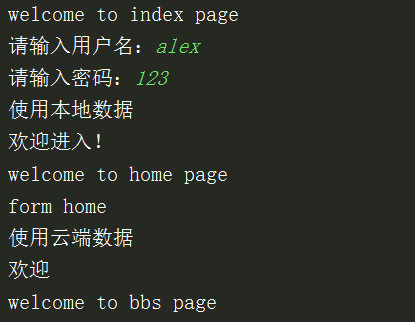初学Python——装饰器
一、什么是装饰器
当我们做好一个产品之后,需要对它进行不断地维护,对某些函数增加一些功能。这个时候如果去修改源代码将是非常不合适的。(原因:1.原则上已经写好的函数尽量不去修改它,因为一旦修改可能会导致不可预知的错误发生或者降低稳定性。2.函数可能被调用很多很多次,如果修改函数有可能会导致调用方式发生改变,会有大量的修改工作。)所以,装饰器就出现了。它可以做到为函数增添新功能的同时而不修改函数本身的源代码。
二、装饰器的原则
1.不能修改被修饰函数的源代码
2.不能修改被修饰函数的调用方式
三、实现装饰器的知识储备
1.函数即“变量”:定义一个函数,相当于将函数体赋值给函数名这个变量。
2.高阶函数:满足以下两个条件之一的函数即为高阶函数:①把函数名当做实参传给另一个函数②返回值中包含函数名
3.嵌套函数:函数是可以嵌套的
四、使用装饰器
高阶函数+嵌套函数=装饰器
装饰器的本质是函数,功能是为其它函数添加附加功能
#现在有两个函数,分别有各自的功能,需求是计算每个函数运行的时间
def text1():
time.sleep(2)
print("this is text1")
def text2(*args,**kwargs):
time.sleep(2)
print("this is text2",args[0],args[1])
可以写装饰器:
def timer(func):
def deco(*args,**kwargs):
start_time=time.time()
func(*args,**kwargs)
end_time=time.time()
print("the function tun time is {0}".format(end_time-start_time))
return deco
其中func()函数是原函数真正的执行过程,deco函数内其他的语句都是新添加功能的语句
装饰器名叫timer
写好装饰器就行了吗?不是,还差一个步骤,在原函数上方增加一条语句,整合到一起:
def timer(func):
def deco(*args,**kwargs):
start_time=time.time()
func(*args,**kwargs)
end_time=time.time()
print("the function tun time is {0}".format(end_time-start_time))
return deco
@timer #此操作的作用是将装饰器的功能加到原函数上 相当于text1=timer(text1)
def text1():
time.sleep(2)
print("this is text1")
@timer #没有@timer语句则不会将装饰器功能加上
def text2(*args,**kwargs): #如果原函数有参数,需要在装饰器中deco上加参数
time.sleep(2)
print("this is text2",args[0],args[1])
text1() #不改变调用方式,且增加了新功能
text2(29000,"hello")
装饰器解析:deco函数用来实现新增功能,timer函数和@timer语句用来使调用方式不发生改变
执行结果:

五、带参数的装饰器
这里说的不是原函数带参数,而是装饰器函数本身带参数
现在有需求,用装饰器实现登陆过程,并且有两种不同的登陆方式:使用本地数据登陆和使用云端数据登陆
#现在有三个网页,其中登陆home时用本地数据,登陆bbs时用云端数据
def index():
print("welcome to index page")
def home():
print("welcome to home page")
return "form home"
def bbs():
print("welcome to bbs page")
需要装饰器:
name="alex"
word="123"
def auth(auth_type):
def auth_out(func):
def deco(*args,**kwargs):
if auth_type=="local": #如果使用本地数据
uesrname=input("请输入用户名:").strip()
password=input("请输入密码:").strip()
if uesrname==name : # 如果用户存在
if password==word:#如果密码正确
print("使用本地数据")
print("欢迎进入!")
return func(*args,**kwargs) #进入home界面
else:
print("密码错误")
else:
print("用户不存在")
elif auth_type=="cloude": #如果使用云端数据
print("使用云端数据")
print("欢迎")
func() # 进入bbs界面
return deco
return auth_out
def index():
print("welcome to index page")
@auth(auth_type="local") #登录home界面使用本地用户数据,在auth()内传参
def home():
print("welcome to home page")
return "form home"
@auth(auth_type="cloude") #登录bbs界面使用云端用户数据
def bbs():
print("welcome to bbs page")
index()
print(home())
bbs()
其实就是将原来的装饰器外层又嵌套了一层函数,用来传递参数。@语句也变成了@auth(auth_type=" ")
运行结果:



